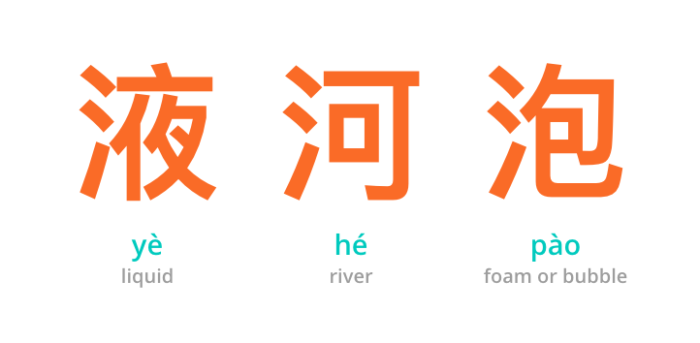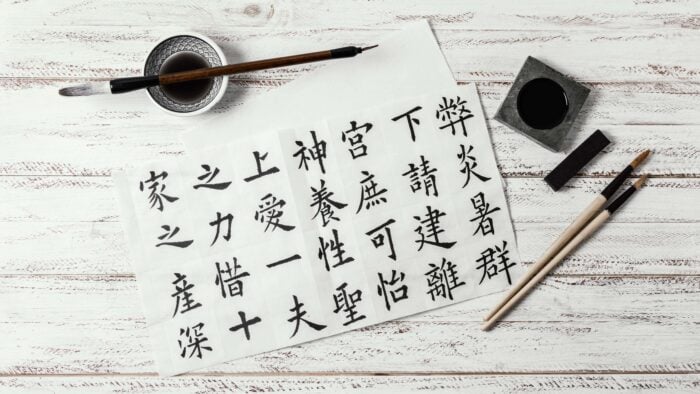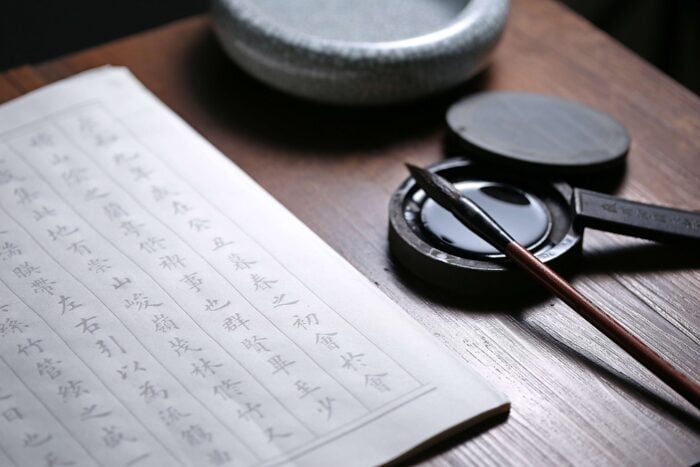The Chinese Alphabet: A Starter’s Guide
A special thanks to our Chinese teacher, Yongtai, for helping us proofread this article.
Writing about the Chinese alphabet is a difficult task. In order to explain how Chinese people write in their language, we have to start by setting the record straight.
You probably know that the English language uses 26 letters, and (less probably) that Russian has 33 characters in its Cyrillic alphabet. Now, when it comes to Chinese, things get a bit more complicated. Why? Because there isn’t such a thing as a Chinese alphabet.
Of course, Chinese has a writing system. A very complex one at that. But the way in which Chinese symbols are put together is very different from how we connect letters to make words. In fact, most Chinese characters make up entirely words, although many words are represented by two symbols or more.
Chinese characters, then, are not letters, but a set of pictures that speakers associate with a specific meaning and a specific series of sounds.
The “Chinese alphabet”, one of the oldest writing systems in the world, slowly evolved over 2000 years until 1950 when the government decided to introduce simplified Mandarin characters to boost China’s literacy rates.
These simplified symbols, the most widely used in present-day China, are the ones we will discuss below.
Discover our Free Trial Chinese Classes with qualified native speakers!
Familiarising Ourselves with the Chinese Alphabet
The Basic 24 Sounds
The table below introduces the 24 basic Chinese symbols, which correspond to keyboard letters with their corresponding literal meaning. This is the most similar thing to a Chinese alphabet you will be able to find.
| Letter | Keyboard character | Basic meaning(s) |
| A | 日 | sun / day |
| B | 月 | moon / month |
| C | 金 | gold / metal |
| D | 木 | tree / wood |
| E | 水 | water |
| F | 火 | fire |
| G | 土 | soil |
| H | 竹 | bamboo |
| I | 戈 | dagger-axe |
| J | 十 | ten |
| K | 大 | big |
| L | 中 | middle / centre |
| M | 一 | one |
| N | 弓 | bow |
| O | 人 | human |
| P | 心 | heart / mind |
| Q | 手 | hand |
| R | 口 | mouth |
| S | 尸 | corpse |
| T | 廿 | twenty |
| U | 山 | hill / mountain |
| V | 女 | woman / female |
| W | 田 | field |
| X | 難 | difficult |
| Y | 卜 | divination |
| Z | 重 | heavy / weight |
You can help your memory by noting cases where English letters are similar to certain Chinese character shapes:
Doesn’t 戈, look like a lowercase <i> that’s been knocked off balance?
Or take 大, which resembles a rotated version of <K>, and 卜, which can be seen as an upside-down <Y>.
Then, there is a major variant of 中, <⼁>, which looks almost exactly like a lowercase <l>, or 廿 which resembles two lowercase <t>’s.
Remove the highest stroke from 山 and you are left with <⼐>, which looks just like <U,u>.
As you can see, Chinese characters are not so difficult to learn after all.
How Many Symbols Are There in the Chinese Alphabet?
There’s not an exact number, but there are approximately 55,000 Chinese characters. Still, bear in mind that no Chinese speaker knows every character.
Actually, to write day-to-day Chinese as comfortably as a native speaker, you would only need to master between 500 and 700 Chinese characters.
And if you want to learn the alphabet in Chinese so you can read Chinese newspapers? Then you’ll need to identify 2,000 characters.
So, how many characters does the average Chinese speaker know? Around 7,000, although well-educated people might know up to 9,000, still a very small percentage of all existing Chinese symbols.
Learn the Alphabet in Chinese Faster: Use Radicals
Chinese radicals are the base elements of Chinese characters that help determine the meaning of each symbol. They are often in the leftmost part of the character but can be on top or on the right too. If you want to look up a word in a dictionary, you will need to know the Chinese radicals, since they are used to organise the entries (since there isn’t a Chinese alphabet, each character is listed under its radical).
These graphic components are often semantic indicators (they tell you what the characters mean), though there are a few cases in which the semantic connection is less clear due to historical changes in meaning.
Let’s see an example.
氵is the water radical, and is made up of three strokes. This means that any word you see that has these three little strokes on the side is related to water in some way. This is great news for learners. Though you may not recognise a character if the water radical is included, the options of what the character might be narrow down by a big margin.
Here are a few Chinese characters where you can see the water radical in action.
How Many Chinese Radicals Are There?
There are a total of 214 radicals in the Chinese language, though some are much better-known than others. They may appear on the left or right side of characters, on top, or underneath.
Introducing Pinyin
If you want to learn Mandarin but you find the lack of a Chinese alphabet too intimidating, don’t sweat it. Pinyin, the official writing system that romanises Chinese for foreigners, is a saving grace for learners who want to communicate in Chinese but are not ready to learn hundreds of intricate characters just yet.
You may have noticed how every time we introduced a character in this article, there was a word next to it. This is Pinyin in action. Developed in the 1950s, this system tries to address the lack of a Chinese alphabet and make studying the language easier. It provides a romanization of Chinese words that tells foreign speakers how the characters should be pronounced.
In Pinyin, words are split into two parts, initials and finals.
As the names indicate, the initials are the first part of the word and they are followed by the finals. For example:
- fēn 分 can be divided into initial (f) and final (ēn)
- shàng 上 can be divided into initial (sh) and final (àng)
- shuō 说 can be divided into initial (sh) and final (uō)
Pinyin is a fantastic way to help beginners learn Chinese.
However, it also has one disadvantage. Although most letters used in Pinyin have one-to-one acoustic equivalents in English, some letters do not have the sound you’d expect.
- For example, the C is not a /k/ or an /s/ sound, but rather a /ts/ sound such as the one in “pits”.
- Similarly, the Q is pronounced with a /ch/ sound like the one in “church”.
- Finally, ZH sounds like an English J, which means that Zhang sounds almost exactly like Jang.
Tips for Memorising the Alphabet in Chinese
When you see how many characters can be found in Mandarin, you can feel a bit intimidated, especially if a great memory is not your forte as a learner. Luckily, there are many things you can do to retain the Chinese alphabet. With a little practice, motivation, and these three tips, you will boost your Chinese in no time!
1. Learn Your Radicals
Like we said before, the Chinese alphabet is based on radicals, which are the base upon which most words are written. Dedicate some time to learning the 250 radicals and you’ll save yourself a lot of trouble in the long run.
The great thing about radicals is that they often resemble the things they represent, which makes them much more memorable than you might initially think.
2. Break Characters Down
Chinese characters are made of essential elements that determine their meaning. Think of these components as a ‘narrative‘ for every character. By analysing the meaning of the radical and the other elements in the character, you come up with a story for it, which will make it both meaningful and memorable.
3. Be Strategic
Organise your learning process intelligently. For example, you can group characters according to similarities, either in radicals or in pronunciation. This will make it easier for you to memorize similar character components and you’ll become aware from the very beginning of how they are pronounced.
Now that you know everything there is to know about the Chinese alphabet (and why we should stop referring to it as a Chinese alphabet to begin with), you’re ready to take the next step.
Discover our Free Trial Chinese Classes with qualified native speakers!
While reading articles about the Chinese alphabet… I mean, writing system, is very useful, if you want to learn Chinese in depth, the best thing you can do is do a course with a native teacher. On our website, you will find information about our tailor-made Chinese lessons taught by Chinese tutors. Do you still have a few questions for our expert teachers? No problem at all. Send us a message now and we’ll get back to you in no time.
Article updated on July 6, 2023


